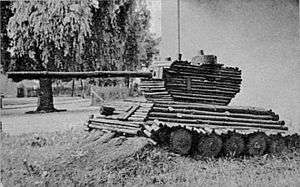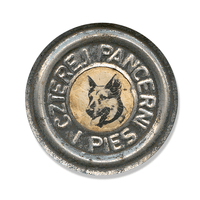Czterej pancerni i pies
| Czterej pancerni i pies | |
|---|---|
| Created by |
Konrad Nałęcki Andrzej Czekalski |
| Starring |
Janusz Gajos Franciszek Pieczka Włodzimierz Press Pola Raksa Wiesław Gołas Roman Wilhelmi Małgorzata Niemirska Aleksander Bielawski Tadeusz Fijewski |
| Opening theme | 'Deszcze niespokojne' by Edmund Fetting |
| Country of origin | Poland |
| Original language(s) | Polish, German, Russian |
| No. of episodes | 21 |
| Production | |
| Running time | 55 minutes |
| Release | |
| Original network | TVP |
| Original release | 25 September 1966 – 1970 |
Czterej pancerni i pies (Polish pronunciation: [ˈt͡ʂtɛrɛj panˈt͡sɛrɲi i ˈpʲɛs], Four tank-men and a dog) was a Polish black and white TV series based on the book by Janusz Przymanowski. Made between 1966 and 1970, the series is composed of 21 episodes of 55 minutes each, divided into three seasons. It is set in 1944 and 1945, during World War II, and follows the adventures of a tank crew and their T-34 tank in the 1st Polish Army. Although both the book and the TV series contain elements of pro-Soviet propaganda, they have achieved and retain a cult series status in Poland, the Soviet Union and other Eastern Bloc countries.
The T-34-85 tank Rudy (Ginger) with the identifying number "102", a German Shepherd dog from Siberia Szarik (pronounced "Sharik" - little ball in Russian, a nickname in the vein of "furball"; in Polish the word is similar to Szary meaning gray and szalik meaning scarf) and to a lesser extent the crew Jan Kos, Gustaw Jeleń, Grigorij Saakaszwili, Tomasz Czereśniak, and their commander and mentor Olgierd Jarosz, as well as other heroes of the series, have become icons in Polish popular culture.
Characters
The crew
- Olgierd Jarosz, "Olgierd" - tank commander, played by Roman Wilhelmi.
- Gustaw Jeleń, "Gustlik" - loader, played by Franciszek Pieczka.
- Jan Kos, "Janek" - gunner/radio operator, later the second commander, played by Janusz Gajos.
- Grigorij Saakaszwili, "Grześ" - driver. Native Georgian, played by Włodzimierz Press.
- Tomasz Czereśniak, "Tomuś, Tomek" - second gunner, played by Wiesław Gołas.
Other
- Marusia "Ogoniok" - Russian nurse and Janek's love interest, played by Pola Raksa.
- Lidia Wiśniewska, "Lidka" - radio operator, played by Małgorzata Niemirska.
- Franek Wichura - truck driver, played by Witold Pyrkosz. His surname means "a gale" which is a relation to his energetic character.
- The Colonel - played by Tadeusz Kalinowski.
- At least two real tanks were used as "Rudy" in this series. One of them, used for tank interior scenes with cameras placed inside the hull, is now displayed in the Museum of Armoured Weapons in Center of Training of Land Forces in Poznań.[1] Although referred to as being armed with 76 mm gun, the tanks seen in the show are the later model T-34/85.
List of episodes


Season I, 1966
- Załoga (Crew)
- Radość i gorycz (Happiness and Bitterness)
- Gdzie my – tam granica (Where We Are, There's the Border)
- Psi pazur (Dog's claw)
- Rudy, miód i krzyże (“Ginger”, Honey and Crosses)
- Most (Bridge)
- Rozstajne drogi (Crossroads [We Are Separating])
- Brzeg morza (Seashore)
Season II, 1969
- Zamiana (Exchange)
- Kwadrans po nieparzystej (A Quarter Past an Odd Hour)
- Wojenny siew (Wartime Sowing)
- Fort Olgierd (Fort Olgierd)
- Zakład o śmierć (Death Bet)
- Czerwona seria (Red Burst)
- Wysoka fala (High Wave)
- Daleki patrol (Long Patrol)
Season III, 1970
- Klin (Wedge)
- Pierścienie (Rings)
- Tiergarten (Tiergarten)
- Brama (Gate)
- Dom (Home)
Popularity
The popularity of the series came from it being one of the first postwar series to depict the era of World War II in a somewhat lighter vein. As the tragic events of the war receded, the Polish public became tired of the mandatory dark, tragic tone of previous television series and films dealing with wartime events. A similar change in attitudes occurred elsewhere in the world at the time. At the same time the series was definitely not a comedy and contained many sad moments and intense battle scenes, while some of the main characters were wounded or killed. The series (especially in the first season) was very well prepared in terms of its technical side due to significant cooperation with the Polish Army and good military training of the actors (most of them being already trained as a two-years military duty was compulsory at the time).
All main heroes were in a way extraordinary. The youngest, Janek Kos, was a marksman, and owner of a well-trained and clever dog Szarik. The loader Gustlik, from Silesia, was very strong, while Grigorij (Russian name Grigoriy) was a skilled driver. Grigorij himself was a Georgian, representing numerous soldiers of the Soviet Army assigned to Polish tank units lacking specialists. The first commander Olgierd Jarosz was a meteorologist and could forecast the weather (in the book he was Russian Wasyl (Vasiliy) Semenov). Tomek, the last member of the crew (appearing later), was joyful and played the accordion.
The upbeat view of the war shown in the series was popular, but in many ways problematic. From the standpoint of military realism, the series is in fact almost grotesque, as its heroes have a very relaxed concept of military discipline, frequently fight their own "private" battles in defiance of orders, and effortlessly defeat German soldiers, who are depicted as faceless military incompetents (a concept referred to as the stormtrooper effect). The series is also loaded with a dose of pro-Soviet propaganda. An emphasis is put on friendship between front-line Polish and Soviet soldiers, but little or no mention of the problems in general Polish-Soviet relations of that era (though they were often suggested in background).
Despite its shortcomings, the series retained its huge popularity and was rerun yearly in Poland until 1989. After 1989 the series is still being sporadically shown in Poland. It was also shown in other countries of the Soviet bloc.
In 2006 the series was released on DVD as a boxed set by TVP.
In 2015, gaming company Wargaming introduced 4 premium vehicles to the game World of Tanks in an event marking VE day, one of the limited vehicles being Rudy, with a crew based on characters from the series including Szarik.
See also
References
- ↑ Archived 19 February 2005 at the Wayback Machine.